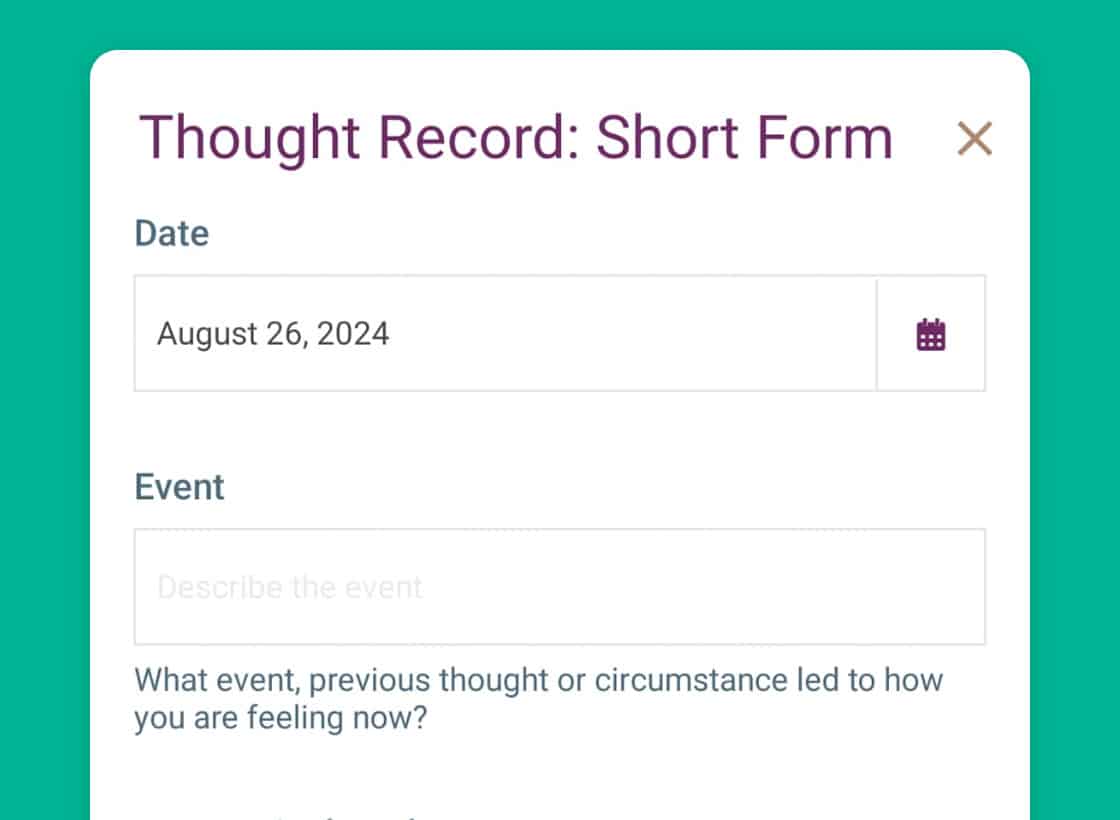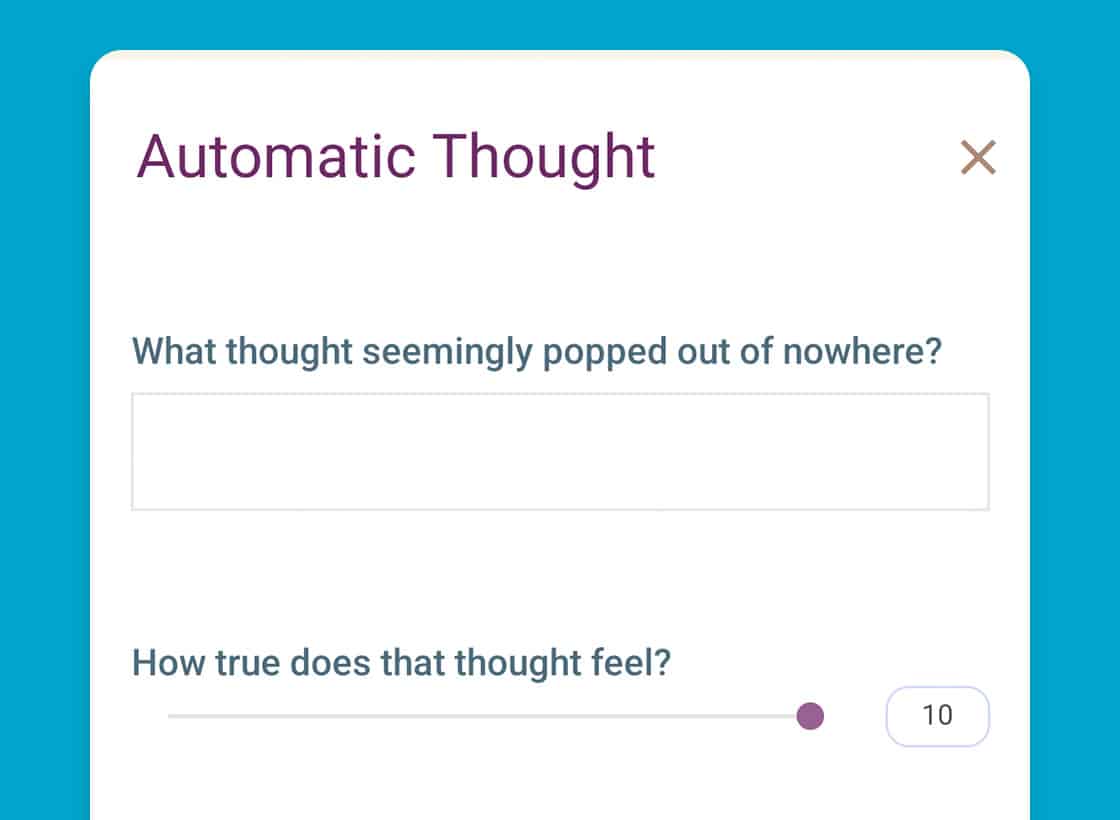Free Download: Thought Record: Short Form Worksheet
Template by Reflective
Best for OCD Anxiety Depression PTSD CBT Trauma En
Use this shortened version of the classic CBT thought record worksheet, also called a thought diary or thought journal, with patients newer to the concept of CBT to help them identify and challenge negative thought patterns, ultimately promoting healthier emotional responses and better coping strategies.
Thought Record: Short Form in the Reflective app is better than a PDF Worksheet
Download the printable PDF worksheet, or share the lighter version of the thought record worksheet with your patient with the Reflective app. Simply enter their email, and they’ll be able to fill it in from the convenience of their phone. Get started for free!
How does Reflective work?
Share exercise with client via Reflective
Client receives email with app link and connection request
Client clicks link to download app
Client accepts your connection and exercises you shared
Client uses app to fill in exercises, gets reminders
What is a short-form Thought Record?
A short-form thought record is a simplified version of the traditional cognitive-behavioral therapy (CBT) worksheet designed to help individuals quickly identify and address negative thought patterns. This condensed version focuses on the essentials, making it easier for those new to CBT to get started with recognizing and challenging their own automatic thoughts.
In the short-form thought record, patients document the situation that triggered their emotions, the automatic thoughts that surfaced, and the emotions they felt in response. The key difference is that it streamlines the process. This allows for quicker reflection while still fostering awareness of how thoughts influence feelings and behaviors.
Using a short-form thought record helps individuals gain initial insight into their cognitive processes without overwhelming them with too much detail. It’s a practical entry point for those beginning CBT, helping them start to recognize patterns in their thinking and identify cognitive distortions. Over time, as they become more comfortable with the process, they can transition to the more detailed full-length thought record.
For therapists, the short-form thought record offers a straightforward tool to introduce clients to cognitive restructuring. It provides a snapshot of the client’s thought patterns, guiding early interventions and helping to build a foundation for deeper work in CBT. This approach empowers clients to engage in their therapy actively, reinforcing their progress and supporting their journey toward healthier thinking habits.
How to use this worksheet
The short form thought record is a straightforward, evidence-based tool that not only enhances your patients’ self-awareness but also actively empowers them to transform their negative thought patterns into healthier, more balanced perspectives. Discover how incorporating this lighter version of the classic CBT thought record into your practice can lead to more engaged, proactive patients and better therapeutic outcomes.
Step 1: Select Thought Record: Short Form from the template library
Therapists can select two versions of thought record to add to the patient’s workbook. This is the second, lighter version, of thought record which is useful to start your patients out on the idea, with fewer fields to fill out to help them get acquainted.
Step 2: Share with your patient
Use the button above to share with your patient. Simply enter their email address and your basic information so they know this is coming from you, and they will get a link to the worksheet.
Step 3: Familiarize yourself with the short form Thought Record
The thought record is broken out into sections: the Event, the Automatic Thought, the Automatic Emotion, the Resulting Behavior, Working Thought, Working Emotion, and the Intended Behavior.
The Event
The patient should describe the event in factual terms: what happened? They should log the time and date, as well.
The Automatic Thought
The patient should describe the immediate thought that popped into their head. They should log how true that thought felt, on a scale of 1 to 10, 10 being “Absolutely True.” They should list any evidence to support or counter that automatic thought.
In this lighter version of the Thought Record, we do not have the cognitive distortion selector, and instead focus on identifying the automatic thought and resulting emotion.
The Automatic Emotion
In this field the patient should write how they felt after the automatic thought, and rate on a numeric scale how strong that feeling was.
Working Thought
Next, the patient should describe a more appropriate thought. After analyzing the situation and examining the evidence, what would be a more appropriate thought? How do they feel after working through the thought?
For each, they can rate on a numerical scale how much they believe the new thought and how strong the feeling was.
Step 4: Repeat as needed
You can set the thought record to filled in as frequently as you feel is appropriate for your patient, and the patient can set up reminders on their schedule. They can fill in the thought record as much as they need to.
The Short Form Thought Record PDF Worksheet
To get a better understanding of how thought records can be effectively utilized in your practice, you can download a sample Thought Record Short Form Worksheet PDF. This resource provides a clear template that demonstrates how to document events, emotions, automatic thoughts, evidence for and against these thoughts, and more balanced perspectives. This practical example will serve as a useful reference, whether you plan to introduce thought records in your sessions or encourage patients to complete them between visits.



